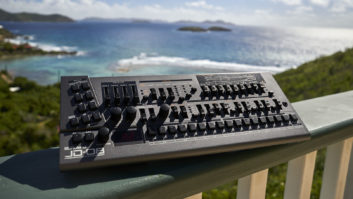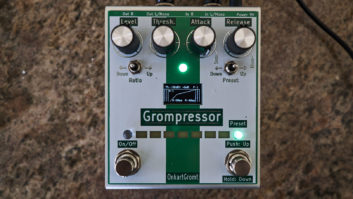To the unappreciative ear, most rap artists sound pretty much the same. Those who aren’t into hip hop recognize rappers by their unusual names or associated news headlines, not by musical styles. But even those who don’t follow the rap game have to admit that Bone Thugs-N-Harmony, whose most recent release is 2000’s BTNHResurrection, is definitely not your average rap group. The five-man group—consisting of Krayzie, Wish, Flesh, Layzie and Bizzy—has a rapid-fire delivery, which isn’t that unusual for rap. But combined with their incredible vocal range, which goes from glass-shattering falsetto to ocean-deep bass, their sheer musicality easily surpasses many of their competing contemporaries.
“They’re more musical in comparison to other rap groups,” states engineer/producer Aaron Connor, from a suite at Artisan Recording Studios in Hollywood. He’s been involved with BTNH for their last three projects and has strong ties with them. “These guys are singers, but don’t tell them that! They take a lot of pride in rapping and that’s what they consider themselves, but they’re singers. They can all sing, and they come up with incredible harmonies that people don’t do in rap. That’s what sets them apart, but now their style has been copied.”
Layzie Bones (aka Steven House), who handles the midrange vocal and rap parts for the group, recalls Eazy-E, the deceased founder of Ruthless Records, and his initial reaction to the group: “He used to tell us, ‘Man, you got a different style.’ We’d say, ‘Nigga, we rapping; ain’t no style.’ We’d hit our harmonies together when we’d say our shit. We flip our flows, and we all help each other in the harmonies part of the shit. But we didn’t know we had a different style ’til the media brought it to our attention.”
Imitation is said to be a form of flattery, but in rap, it’s a much-practiced art form, with a lot of BTNH sound-alikes vying for a slice of the pie. Early on, before the Platinum CDs, BTNH attributed their uniqueness to their Cleveland, Ohio, roots. “The Midwest is just waiting for its time to blow,” says Layzie from the offices of Ruthless Records in Los Angeles. “The East had theirs, the West got their time and so did the South. But in the Midwest, there’s a whole bunch of talent there that the industry hadn’t tapped into until we hit. We get the best of all worlds, because we don’t just listen to East Coast, West Coast or the South—we listen to everything. That’s where we get the upper hand. From Cleveland to Detroit to Chicago, we got some shit jumping out our way.”
The aptly titled BTNHResurrection came out after a three-year layoff for the group, during which a raft of solo projects and various nonmusical issues kept the bandmembers apart. To Connor, “They keep growing and the songs keep getting better, with the songwriting being the most significant difference. Also, the way that we work and the instrumentation keeps getting deeper.”
A change on this album is the infusion of inputs from multiple producers. On their previous releases, DJ U-Neek wrote and produced the majority of the tracks, but now, according to Connor, “The songwriting got stronger, because there was more variety to the beats with different flavors from some people.”
BTNH’s creative process for BTNHResurrection involved various producers auditioning rhythm tracks, usually on DAT, for consideration. The “beats,” as they’re called, could just be a simple groove or a full-blown song. “They would decide on which ones they felt,” says Connor of the band’s selection process. “If they didn’t feel a particular beat, they might still keep it and come back to it later. But usually whatever they feel initially inspires them, and they’ll start writing lyrics to it immediately. If we need extra music, we’ll add that later.”
From the artist’s perspective, Layzie says, “Sometimes all of us are in the studio together and we’ll just vibe to a beat. Somebody will have a concept and we’ll just all go off of that. Or Krayzie will drop a hook and everyone else will follow after that with verses. It’s just like preparing a meal—you start with the little basics and you just keep adding to it ’til it all comes together. We do tracks ourselves, but right now we’re really focusing on working with DJ U-Neek, L.T. Hutton, Jimmy “JT” Thomas and other more solid producers. Krayzie is really the producer in our group; he’s made a lot of tracks for our previous CDs. The bottom line for us when it comes to producers is, if they got the shit, some heat for BTNH, we’ll add the flavor to it. It just comes together like that.”
The 17 completed tracks on BTNHResurrection were culled from 40 tunes; in fact, they originally considered putting out a double CD, but because they’d done that three years ago with The Art of War, they decided to whittle it down to one. “This one was the quickest so far,” states Connor. “It was basically three months of tracking and six weeks of mixing. E. 1999 Eternal took about 10 months from beginning to end. The Art of War took about 14 months. We’re always cutting way more songs than we need; that way we always come in with real strong records. A lot of other acts will cut a million songs and throw them all out on the public, and a lot of them are just garbage.”
Connor mixed about half of the CD’s tracks; other engineers on the project included Al Machera and Tim Nitz. The mix was done at Sound Castle in L.A.’s Silver Lake area on an SSL SL 4000 G mixing console. Most of the members of BTNH have small home studios, and they do some production work there, but when it comes to putting a finished master together, they prefer to leave it to the professionals. “Aaron’s my cat,” states Layzie. “We’ve been working him since the 1999 album. If you listen to the whole sound and the perfection of our CDs, that comes from his ears. Personally, my favorite thing is the stage. Period. I like being in the huddle on street corners rapping. But I also like being in the studio where I can concentrate, touching knobs and tweaking my vocals. I just love the whole process.”
Because of the numerous producers involved in the project, Connor wasn’t as intimately involved in the recording of the CD as he was on the earlier projects. In most cases, the producers cut the tracks, and Connor came in to help out on recording the all-important vocals and getting the mix together. “On previous records, I’ve been very involved, and we cut everything from scratch,” he notes. “Most of the time live musicians will play, and then we’ll sample from that, so that we can be as tight as possible. On this record, everything came to me pretty much complete.”
The rappers couldn’t say in technical terms what exactly Connor does that they like, but they know they like it. The engineer, who also works with other hip hop groups, says, “Compression is my big thing. I’ll compress the vocals to tape; that’s how they come out so tight. I usually use a dbx 160x or a TL Audio 2 compressor, and I’ll compress the vocals maybe five or six dB to tape. Then I’ll transfer the tape to Pro Tools and compress them again slightly. By the time the vocals are done, I’ve compressed them three times.
“When I mix I’ll use some fat, warm tube compressors, like the Manley or Avalon. BTNH leaves all the mixing up to me. Matter of fact, if anyone is in the room, I’ll usually kick them out. I need high levels of concentration, and I can’t even have a conversation going on. For Eternal, I mixed the record down here [Artisan Recording Studios]. They didn’t even know this place existed. They came in after everything was mixed, we played the record for them and they loved it. So that’s the way things have been done since that time.”
Connor knows that top-notch sonics have not always been important in rap and hip hop, but he believes that is changing now, and he is happy to be at the vanguard of that change. “One point that I really want to emphasize,” asserts Connor, “is that these records are really high-quality records. Our main goal is to have the fans appreciate what we’re doing and be entertained. We really care about them.”
And this time out, the band has tried hard to broaden their perspective as a way to bring in new fans. Layzie says, “We’re not just talking about the ‘hood’ on this record; we go to other levels. We got songs such as ‘Change the World’ and ‘Who’s Serving the Fiends,’—there’s more issues now.” Bizzy, the youngest member of the group who does the first tenor parts, adds, “‘Battlezone’ and ‘Murder One’ are standouts. To me, the record is about prophecies we see and things that have happened in the past. It’s definitely an emotional album, but we want to complement what’s already out and keep it tight. If we don’t keep it real and have the music flowing, there’s really no reason to come out.”







